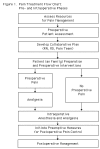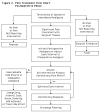This publication is provided for historical reference only and the information may be out of date.
This guideline addresses the care of patients with acute pain after operation, medical procedures, or trauma. (Methods used to develop the guideline are in appendix A.) It outlines the physiological basis for pain and cites clinical studies linking effective postoperative pain management with improved patient outcomes. The guideline also describes practices that can minimize or eliminate acute pain. Rigid prescriptions for postoperative pain control are inappropriate because patients vary greatly in the severity of their preexisting pain, medical conditions, and pain experiences; the extensiveness of pathology and associated operations; responses to interventions; personal preferences; and the settings in which they receive care. Instead, this guideline offers clinicians a coherent yet flexible approach to pain assessment and management in daily practice. This guideline has four major goals:
- Reduce the incidence and severity of patients' postoperative or posttraumatic pain.
- Educate patients about the need to communicate unrelieved pain so they can receive prompt evaluation and effective treatment.
- Enhance patient comfort and satisfaction.
- Contribute to fewer postoperative complications and, in some cases, shorter stays after surgical procedures.
Need for Aggressive Postoperative Pain Control
Pain is an unpleasant sensory and emotional experience arising from actual or potential tissue damage or described in terms of such damage (International Association for the Study of Pain, 1979 ; Merskey, 1964). No matter how successful or how deftly conducted, operations produce tissue trauma and release potent mediators of inflammation and pain (Hargreaves, and Dionne, 1991).
Pain is just one response to the trauma of surgery, however. In addition to the major stress of surgical trauma and pain, the substances released from injured tissue evoke "stress hormone" responses in the patient. Such responses promote breakdown of body tissue; increase metabolic rate, blood clotting, and water retention; impair immune function; and trigger a "fight or flight" alarm reaction with autonomic features (e.g., rapid pulse) and negative emotions (Dinarello, 1984 ; Egdahl, 1959 ; Kehlet, 1982 ; Kehlet, Brandt, and Rem, 1980). Pain itself may lead to shallow breathing and cough suppression in an attempt to "splint" the injured site, followed by retained pulmonary secretions and pneumonia (Anscombe, and Buxton, 1958 ; Hewlett, and Branthwaite, 1975 ; Latimer, Dickman, Day, Gunn, and Schmidt, 1971 ; Marshall, and Wyche, 1972 ; Sydow, 1989). Unrelieved pain also may delay the return of normal gastric and bowel function in the postoperative patient (Wattwil, 1989).
The physiological and psychosocial risks associated with untreated pain are greatest in frail patients with other illnesses such as heart or lung disease, those undergoing major surgical procedures such as aortic surgery, and the very young or very old. Because of advances in surgical and anesthetic techniques, it is now common for such patients to undergo operations once dismissed as prohibitively risky.
Approximately 23.3 million operations were performed in the United States in 1989 (Peebles, and Schneidman, 1991), and most of these involved some form of pain management. Unfortunately, clinical surveys continue to show that routine orders for intramuscular injections of opioid "as needed" will leave more than half of postoperative patients with unrelieved pain due to undermedication (Marks, and Sachar, 1973 ; Donovan, Dillon, and McGuire, 1987 ; Oden, 1989 ; Sriwatanakul, Weis, Alloza, Kelvie, Weintraub, and Lasagna, 1983). In the past, postoperative pain was thought to be inevitable, a harmless though intense discomfort that the patient had to tolerate. Unrelieved pain after surgery or trauma is often unhealthy; fortunately, it is preventable or controllable in an overwhelming majority of cases. Patients have a right to treatment that includes prevention or adequate relief of pain.
Recognition of the widespread inadequacy of pain management has prompted recent corrective efforts within multiple health care disciplines, including surgery (Kehlet, 1989a ; Royal College of Surgeons, 1990), anesthesiology (Phillips, and Cousins, 1986 ; Ready, Oden, Chadwick, Bendetti, Rooke, Caplan, and Wild, 1988); nursing (Jacox, 1977 ; American Nurses Association, 1991), and pain management groups (National Health and Medical Research Council of Australia, 1988 ; American Pain Society, 1989 ; International Association for the Study of Pain, 1991). Although it is not practical or desirable to eliminate all postoperative pain, this clinical practice guideline sets forth procedures to minimize the incidence and severity of acute pain after surgical or medical procedures and trauma. The guideline is designed to help clinicians, patients, and patients' families understand the assessment and treatment of postoperative and other acute pain in both adults and children.
Health care is both a technical and an ethical enterprise. The ethical obligation to manage pain and relieve the patient's suffering is at the core of a health care professional's commitment. While medical treatments often involve risks and burdens, anything harmful to the patient, including postoperative pain, should be minimized or prevented if possible. The ethical importance of pain management is further increased when additional benefits for the patient are realized -- earlier mobilization, shortened hospital stay, and reduced costs. If inadequate pain management results from a clinician's conflict between reducing pain and avoiding potential side effects and/or legal liability, achieving greater technical competence and knowledge of risks and benefits can help to reduce such conflicts.
Prevention is Better than Treatment
Pain is dynamic. Without treatment, sensory input from injured tissue reaches spinal cord neurons and causes subsequent responses to be enhanced. Pain receptors in the periphery also become more sensitive after injury. Recent studies demonstrate long-lasting changes in cells within spinal cord pain pathways after a brief painful stimulus (Bullit, 1989 ; Fitzgerald, 1990 ; Hanley, 1988 ; Hunt, Pini, and Evan, 1987 ; Przewlocki, Haarmann, Nikolarakis, Herz, and Hollt, 1988). Such physiological studies confirm longstanding clinical impressions that established pain is more difficult to suppress (McQuay, 1989 ; Wall, 1988 ; Woolf, and Wall, 1986). The health care team should encourage patients to request pain medication before the pain becomes severe and difficult to control. Furthermore, the team should teach patients simple relaxation exercises to help decrease postoperative pain (Ceccio, 1984).
Aggressive pain prevention and control that occurs before, during, and after surgery can yield both short- and long-term benefits. In the very short term, for example, a patient's first request for analgesia after orthopedic surgery occurs later after operations performed with opioid premedication and intraoperative nerve blocks than after general anesthesia alone (McQuay, Carroll, and Moore, 1988). In the short term, patients who undergo cesarean section under epidural anesthesia request less postoperative pain medication in the next 3 days than patients who have general anesthesia (Hanson, Hanson, and Matousek, 1984). Also in the short term, postoperative patients able to self-medicate with small intravenous doses of opioids such as morphine metered out by a programmable infusion pump -- patient controlled analgesia or PCA (Ferrante, Ostheimer, and Covino, 1990) -- have less pain and are more satisfied with their pain relief. These patients tend to be discharged earlier from the hospital compared with those given the same drug on an "as-needed" basis (Guideline Report, in press ; Bollish, Collins, Kirking, and Bartlett, 1985 ; Eisenach, Grice, and Dewan, 1988 ; Jackson, 1989 ; Wasylak, Abbott, English, and Jeans, 1990).
In the long term, after elective limb amputation for vascular insufficiency, patients who receive epidural analgesia before an operation are less likely to have chronic phantom limb pain, in contrast to those conventionally treated (Bach, Noreng, and Tjellden, 1988). Pilot studies such as these that show diverse benefits of aggressive pain treatment complement controlled clinical trials which indicate that postoperative morbidity and mortality decrease in high-risk populations such as the very young (Anand, Sippell, and Aynsley- Green, 1987) or very old (Egbert, Parks, Short, and Burnnett, 1990) when postoperative care includes aggressive pain relief.
Much of the clinical research cited here is preliminary and needs to be confirmed by properly designed clinical trials. Yet, when considered with laboratory reports and well-documented undertreatment of pain in hospitalized patients, it is likely that routine provision of proactive, aggressive pain treatment will benefit large numbers of postoperative patients. To ensure these benefits, institutions must develop and use formal procedures to assess pain and employ patient-based feedback to gauge the effectiveness of pain control(American Pain Society, 1990, 1991). The flow charts shown in Figures 1 and 2 indicate the points at which caregivers must make decisions about assessing and controlling patient pain.

Figure
Figure 1. Pain Treatment Flow Chart: Pre- and Intraoperative Phases.

Figure
Figure 2. Pain Treatment Flow Chart: Postoperative Phases.
Organization of the Guideline
To derive maximum benefit, clinicians should read the entire guideline. However, the guideline is organized so that users can go easily to those sections of immediate interest. Following a discussion of why clinicians should take an aggressive approach to prevention and control of postoperative pain, methods of pain assessment are described. Pharmacologic and nonpharmacologic methods of pain control are then presented for general control of postoperative pain, followed by discussion of pain control for specific operative sites and for specific types of patients. The final section discusses institutional responsibility for effective pain management. The appendixes contain a brief description of the methods used for scientific review and a table of scientific evidence for pain intervention, pain assessment tools, drug dosage tables for adults and children, and relaxation exercises.
Publication Details
Copyright
Publisher
Agency for Health Care Policy and Research (AHCPR), Rockville (MD)
NLM Citation
Acute Pain Management Guideline Panel. Acute Pain Management: Operative or Medical Procedures and Trauma. Rockville (MD): Agency for Health Care Policy and Research (AHCPR); 1992 Feb. (AHCPR Clinical Practice Guidelines, No. 1.) 1, Introduction.

